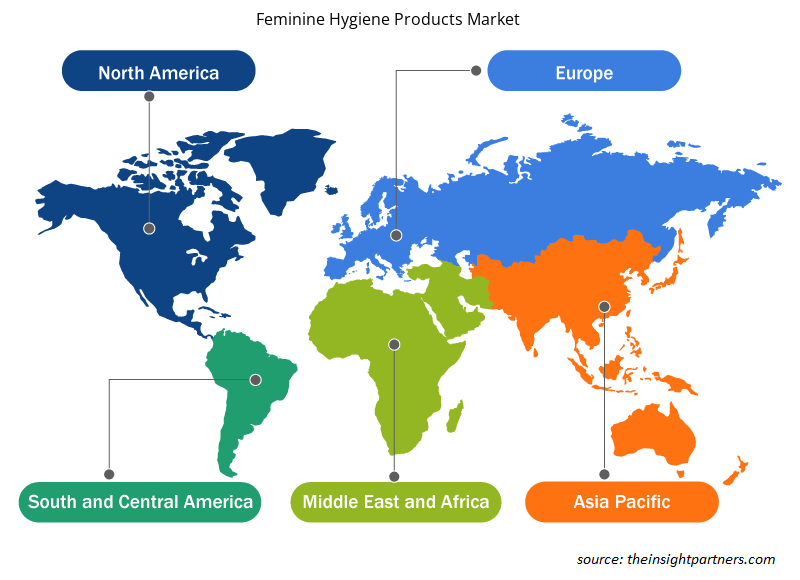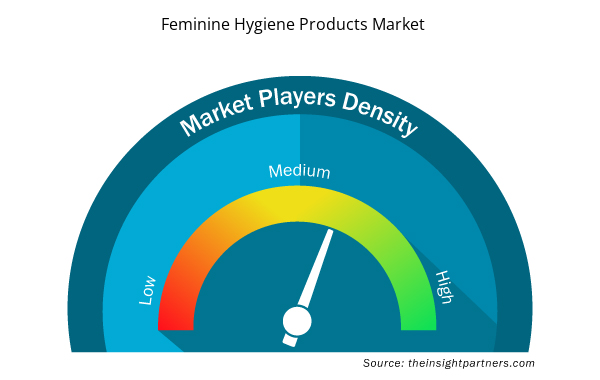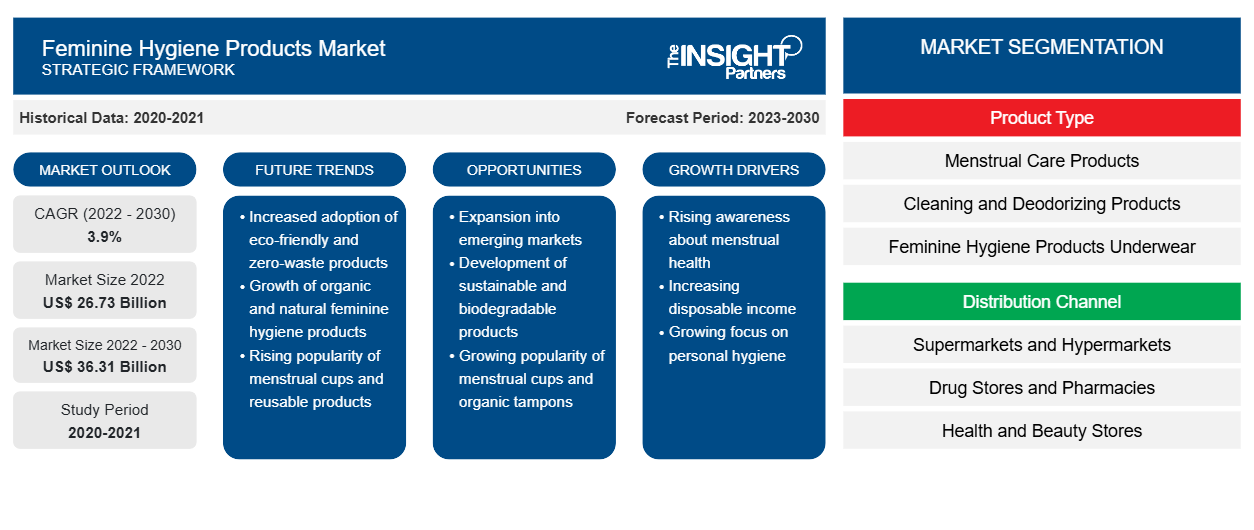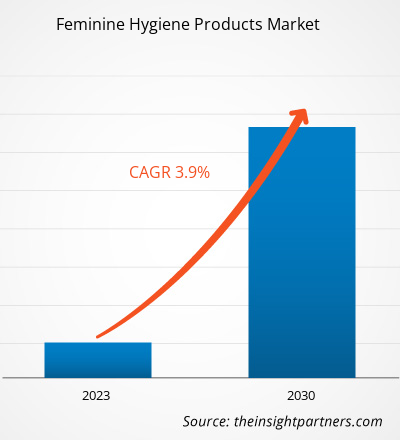[Informe de investigación] El mercado de productos de higiene femenina se valoró en US$ 26.733,33 millones en 2022 y se proyecta que alcance los US$ 36.305,29 millones en 2030; se espera que registre una CAGR del 3,9% de 2022 a 2030.
Perspectivas del mercado y opinión de analistas:
El mercado de productos de higiene femenina en Europa está impulsado principalmente por un aumento de la conciencia sobre el mantenimiento de la higiene personal y el aumento de las iniciativas de los organismos gubernamentales con respecto a la higiene femenina. Además, la conciencia sobre la higiene personal en las mujeres está aumentando debido a varias iniciativas gubernamentales y campañas en las redes sociales. Estas iniciativas y campañas contribuyen a una mejor comprensión y aceptación de los productos de higiene femenina. Por lo tanto, el aumento de la conciencia sobre la higiene personal está impulsando el crecimiento del mercado de productos de higiene femenina. Las regiones como América del Norte, Europa y Asia Pacífico son el centro de Edgewell Personal Care Co, Kimberly-Clark Corp, Lune Group Oy Ltd, Me Luna Gmbh, Mooncup Ltd, Ontex BV, Essity Ab, Wuka Ltd, Cotton High Tech SL y The Procter & Gamble Co, que generan una alta demanda de productos de higiene femenina. Por lo tanto, la presencia de dichas empresas impulsa el crecimiento del mercado mundial de productos de higiene femenina .
Factores impulsores del crecimiento y desafíos:
Las iniciativas estratégicas de los actores clave del mercado han impulsado el crecimiento del mercado mundial de productos de higiene femenina. Los fabricantes están invirtiendo fuertemente en proyectos de investigación y desarrollo, asociaciones, planes de expansión y colaboraciones para lanzar productos innovadores que atraigan a una gran base de consumidores. Por ejemplo, en junio de 2020, Pee Safe lanzó una nueva gama de productos de higiene íntima, que incluye un aerosol desinfectante para ropa interior, toallas sanitarias reutilizables, bolsas desechables oxobiodegradables y un polvo de higiene íntima. Los actores clave del mercado están adoptando iniciativas estratégicas como fusiones y adquisiciones para expandir su cartera de productos y presencia geográfica. Por ejemplo, en noviembre de 2022, la empresa Edgewell Personal Care anunció la adquisición de Billie Inc. La adquisición tenía como objetivo ampliar su cartera de productos de marcas de primer nivel de afeitado femenino y cuidado corporal.
Además, los productos depilatorios naturales y limpios están ganando popularidad en todo el mundo debido a la mayor conciencia de los efectos nocivos de los productos químicos y la creciente inclinación a utilizar productos de cuidado personal ecológicos y limpios. Esta tendencia ha impulsado a los fabricantes a desarrollar productos naturales en función de las necesidades de los clientes. Por ejemplo, Reckitt Benckiser Group Plc lanzó la gama de cremas depilatorias Veet Pure en 2022, reformulando así sus productos. La gama de productos incluye extractos naturales de pepino, aloe vera y aceite de semilla de uva. Por tanto, estos lanzamientos de productos y otras estrategias para satisfacer la creciente demanda de los consumidores contribuyen al crecimiento del mercado.
Personalice este informe según sus necesidades
Obtendrá personalización en cualquier informe, sin cargo, incluidas partes de este informe o análisis a nivel de país, paquete de datos de Excel, así como también grandes ofertas y descuentos para empresas emergentes y universidades.
- Obtenga las principales tendencias clave del mercado de este informe.Esta muestra GRATUITA incluirá análisis de datos, desde tendencias del mercado hasta estimaciones y pronósticos.
Segmentación y alcance del informe:
El mercado global de productos de higiene femenina está segmentado en función del tipo de producto, canal de distribución y geografía. Según el tipo de producto, el mercado de productos de higiene femenina se segmenta en productos para el cuidado menstrual, productos de limpieza y desodorización y ropa interior de higiene femenina. Según el canal de distribución, el mercado de productos de higiene femenina se segmenta en supermercados e hipermercados, farmacias y droguerías, tiendas de salud y belleza, venta minorista en línea y otros. El mercado de productos de higiene femenina según la geografía se segmenta en América del Norte (EE. UU., Canadá y México), Europa (Alemania, Francia, Italia, Reino Unido, Rusia y resto de Europa), Asia Pacífico (Australia, China, Japón, India, Corea del Sur y resto de Asia Pacífico), Oriente Medio y África (Sudáfrica, Arabia Saudita, Emiratos Árabes Unidos y resto de Oriente Medio y África) y América del Sur y Central (Brasil, Argentina y resto de América del Sur y Central).
Análisis segmental:
Según el tipo de producto, el mercado de productos de higiene femenina se segmenta en productos para el cuidado menstrual, productos de limpieza y desodorización y ropa interior para la higiene femenina. El segmento de productos para el cuidado menstrual tuvo una participación significativa en el crecimiento del mercado de productos de higiene femenina y se espera que registre un crecimiento sustancial durante el período de pronóstico. Los productos para el cuidado menstrual, que incluyen toallas sanitarias, bragas menstruales, salvaslips, toallitas femeninas, tampones y copas menstruales, toallas sanitarias y compresas, están ganando terreno debido a la creciente conciencia sobre la higiene femenina entre las mujeres de todo el mundo. Además, el uso creciente de estos productos está fomentando la sensibilidad ambiental entre la población. Por lo tanto, las mujeres profesionales que trabajan y otras poblaciones sensibles al medio ambiente están adoptando productos menstruales que son cómodos y desechables.
Los productos para el cuidado menstrual suelen desecharse y acabar en vertederos, generando enormes volúmenes de residuos no biodegradables que persisten en el medio ambiente en forma de microplásticos, lo que supone una amenaza importante para los ecosistemas acuáticos y terrestres. Debido a la mayor concienciación sobre este problema, muchas personas están optando por productos menstruales reutilizables, como copas y discos menstruales y compresas reutilizables de tela. Según un artículo publicado en el sitio web de la BBC y en el índice de términos de búsqueda de Google Trends, las búsquedas de productos menstruales reutilizables han aumentado cada año.
Análisis regional:
Según la geografía, el mercado de productos de higiene femenina se divide en cinco regiones clave: América del Norte, Europa, Asia Pacífico, América del Sur y Central, y Oriente Medio y África. El mercado mundial de productos de higiene femenina estuvo dominado por América del Norte y registró unos 5.000 millones de dólares estadounidenses en 2022. Europa es el segundo contribuyente principal con más del 20% de la participación del mercado mundial. Se espera que Asia Pacífico crezca a una CAGR de más del 5% durante el período de pronóstico. El mercado de productos de higiene femenina de América del Norte está segmentado en Estados Unidos, Canadá y México. El crecimiento del mercado de productos de higiene femenina en América del Norte se atribuye a un mayor nivel de vida, mejores prácticas de saneamiento y mayores niveles de ingresos para las mujeres. La industria ha sido testigo de una innovación continua en productos de higiene femenina, con empresas que introducen productos nuevos y mejorados para satisfacer las diferentes necesidades y preferencias de los clientes. Además, la creciente preocupación por los problemas medioambientales, como el aumento de la población de plástico y el calentamiento global, ha animado a las mujeres a optar por productos sostenibles y ecológicos. En América del Norte, se envían anualmente a los vertederos unos 20 mil millones de toallas sanitarias, tampones y aplicadores. Los productos como las copas menstruales y las compresas de tela han ganado popularidad debido a su relación coste-beneficio y su reducido impacto medioambiental. La creciente demanda de productos de higiene femenina sostenibles y ecológicos ha dado lugar a la innovación de productos y al lanzamiento de productos al mercado. Por ejemplo, en diciembre de 2022, Trace Femcare anunció el lanzamiento de tampones de algodón y fibra de cáñamo regenerativa con beneficios para el clima. Los productos abordaban el aumento de la población de plástico y el calentamiento global provocado por los tampones no desechables. Por tanto, todos los factores anteriores influyen en el crecimiento del mercado de productos de higiene femenina en América del Norte.
Desarrollos industriales y oportunidades futuras:
A continuación se enumeran diversas iniciativas adoptadas por los actores clave que operan en el mercado de productos de higiene femenina:
- En noviembre de 2021, Ontex BV lanzó su marca NAT en China. Los productos que lanzó fueron tampones, compresas, salvaslips y bragas menstruales.
- En mayo de 2021, Poise, una marca de Kimberly Clark, anunció su asociación con Whitney Port y lanzó sus protectores y compresas 2 en 1.
Perspectivas regionales del mercado de productos de higiene femenina
Los analistas de Insight Partners explicaron en detalle las tendencias y los factores regionales que influyen en el mercado de productos de higiene femenina durante el período de pronóstico. Esta sección también analiza los segmentos y la geografía del mercado de productos de higiene femenina en América del Norte, Europa, Asia Pacífico, Oriente Medio y África, y América del Sur y Central.

- Obtenga datos regionales específicos para el mercado de productos de higiene femenina
Alcance del informe de mercado de productos de higiene femenina
| Atributo del informe | Detalles |
|---|---|
| Tamaño del mercado en 2022 | US$ 26,73 mil millones |
| Tamaño del mercado en 2030 | US$ 36.31 mil millones |
| CAGR global (2022-2030) | 3,9% |
| Datos históricos | 2020-2021 |
| Período de pronóstico | 2023-2030 |
| Segmentos cubiertos | Por tipo de producto
|
| Regiones y países cubiertos | América del norte
|
| Líderes del mercado y perfiles de empresas clave |
|
Densidad de actores del mercado: comprensión de su impacto en la dinámica empresarial
El mercado de productos de higiene femenina está creciendo rápidamente, impulsado por la creciente demanda de los usuarios finales debido a factores como la evolución de las preferencias de los consumidores, los avances tecnológicos y una mayor conciencia de los beneficios del producto. A medida que aumenta la demanda, las empresas amplían sus ofertas, innovan para satisfacer las necesidades de los consumidores y aprovechan las tendencias emergentes, lo que impulsa aún más el crecimiento del mercado.
La densidad de actores del mercado se refiere a la distribución de las empresas o firmas que operan dentro de un mercado o industria en particular. Indica cuántos competidores (actores del mercado) están presentes en un espacio de mercado determinado en relación con su tamaño o valor total de mercado.
Las principales empresas que operan en el mercado de productos de higiene femenina son:
- Compañía de cuidado personal Edgewell
- Corporación Kimberly-Clark
- Grupo Lune Oy Ltd
- Me Luna GmbH
- Mooncup Ltd
Descargo de responsabilidad : Las empresas enumeradas anteriormente no están clasificadas en ningún orden particular.

- Obtenga una descripción general de los principales actores clave del mercado de productos de higiene femenina
Impacto del COVID-19:
Antes de la pandemia de COVID-19, el aumento de la tasa de alfabetización femenina y la mayor conciencia sobre la higiene menstrual impulsaron principalmente el mercado de productos de higiene femenina. Sin embargo, la industria de bienes de consumo experimentó impactos adversos de la pandemia durante el primer trimestre de 2020. La pandemia de COVID-19 también provocó una recesión económica en los primeros meses de 2020, lo que generó dificultades financieras para los consumidores de ingresos bajos y medios. Como resultado, las personas solo compraron productos básicos básicos, como alimentos y productos médicos críticos, lo que redujo las ventas de productos de higiene femenina.
Muchas empresas se recuperaron a medida que los gobiernos de varios países suavizaron las restricciones después de los meses iniciales de confinamiento en 2020. La introducción de la vacuna contra la COVID-19 ofreció un mayor alivio a la angustiosa situación de la pandemia, lo que llevó a un aumento de las actividades comerciales. La reanudación de las operaciones en las unidades de fabricación tuvo un impacto positivo en el mercado de productos de higiene femenina y condujo a la recuperación de la producción de productos de higiene femenina. Los fabricantes superaron la brecha de oferta y demanda, ya que se les permitió operar a plena capacidad.
Panorama competitivo y empresas clave:
Entre los actores destacados que operan en el mercado global de productos de higiene femenina se encuentran Edgewell Personal Care Co, Kimberly-Clark Corp, Lune Group Oy Ltd, Me Luna Gmbh, Mooncup Ltd, Ontex Bv, Essity Ab, Wuka Ltd, Cotton High Tech SL y The Procter & Gamble Co., entre otros. Estos actores ofrecen productos de higiene femenina de vanguardia con características innovadoras para brindar una experiencia superior a las consumidoras.
- Análisis histórico (2 años), año base, pronóstico (7 años) con CAGR
- Análisis PEST y FODA
- Tamaño del mercado Valor/volumen: global, regional, nacional
- Industria y panorama competitivo
- Conjunto de datos de Excel



Report Coverage
Revenue forecast, Company Analysis, Industry landscape, Growth factors, and Trends

Segment Covered
This text is related
to segments covered.

Regional Scope
North America, Europe, Asia Pacific, Middle East & Africa, South & Central America

Country Scope
This text is related
to country scope.
Preguntas frecuentes
Based on products type, menstrual care products segment mainly has the largest revenue share. Menstrual care products include sanitary pads/napkins, tampons, menstrual cups, reusable cloth pads, liners, and menstrual discs. Sanitary pads and tampons are among the most widely used products by females during menstruation. They are made of materials such as cellulosic fibers; synthetic polymers such as polyester, polyethylene, and polypropylene; cotton; and superabsorbent polymers. Products made from superabsorbent polymers absorb low to heavy period flow and allow women to perform their daily chores and other physically rigorous activities, such as playing and traveling, without the stress of leakage and stains.
Initiatives by governments and organizations to provide opportunities in the coming years for the feminine hygiene products. The increasing prices of feminine hygiene products owing to higher taxes prevent consumers from buying them. Thus, they search for alternatives, which can hamper their health. However, with increasing awareness about feminine hygiene, various governments of globally are taking various initiatives, such as reducing taxes on feminine hygiene products and distributing them free of cost. For instance, in Germany, the tax rate on sanitary items was cut from 19% to 7% as of 1 January 2020. Ireland levies no value-added tax on tampons, panty liners, and sanitary towels. Ireland is the only EU country with a zero-tax rate on sanitary goods. Thus, reducing taxes on feminine hygiene products accelerates their demand across the region.
Asia Pacific accounted for the largest share of the global feminine hygiene products market. In Europe, the rapidly changing lifestyles of consumers are making them opt for convenient food solutions and ready-to-eat products such as frozen food, feminine hygiene products, biscuits, cookies, etc. The demand for feminine hygiene products is significantly increasing across the region owing to the established status of bakery products as a staple food in many European countries such as Germany, Russia, France, Italy, and the UK, making Europe one of the major markets of feminine hygiene products. Also, the growing health consciousness among Europeans is boosting the demand for feminine hygiene products containing fibers, vitamins and minerals, whole grains, vegetables, and gluten-free bakery products such as gluten-free functional and gluten-free artisanal feminine hygiene products.
Rising awareness of menstrual hygiene are driving the feminine hygiene products market. In recent times, the women population in globally has become more aware of menstrual hygiene, particularly among the working class. Since 2012, several public health organizations have started focusing on menstruation hygiene management (MHM). Grassroots workers, social entrepreneurs, and United Nations agencies are also contributing to this noble cause. For example, in May 2013, WASH United conducted a 28-day social media campaign called "May #MENSTRAVAGANZA" on Twitter to generate awareness about menstruation and MHM. In January 2021, Raigarh district in Chhattisgarh, India, announced the launch of ‘Pavna,’ a unique community-based menstrual hygiene program.
The major players operating in the global feminine hygiene products market are Edgewell Personal Care Co, Kimberly-Clark Corp, Lune Group Oy Ltd, Me Luna GmbH, Mooncup Ltd, Ontex BV, Essity AB, Wuka Ltd, Cotton High Tech SL, The Procter & Gamble Co.
Based on the distribution channel, online retail segment is projected to grow at the fastest CAGR over the forecast period. E-commerce platforms are preferred by consumers owing to the convenience of shopping various products from remote locations, availability of a wide range of products of different brands, exclusive discounts and offers on these sites, and home delivery services (free or paid) offered by these platforms. Additionally, online platforms provide product descriptions, user reviews, and ratings, which help consumers choose the right product. Innovative feminine hygiene products such as menstrual cups, reusable period and incontinence underwear, menstrual discs, and tampon applicators are widely available across e-commerce channels.
Trends and growth analysis reports related to Consumer Goods : READ MORE..
The List of Companies - Feminine Hygiene Products Market
- Edgewell Personal Care Co.
- Kimberly-Clark Corp
- Lune Group Oy Ltd
- Me Luna GmbH
- Mooncup Ltd
- Ontex BV
- Essity AB
- Wuka Ltd
- Cotton High Tech SL
- The Procter & Gamble Co
The Insight Partners performs research in 4 major stages: Data Collection & Secondary Research, Primary Research, Data Analysis and Data Triangulation & Final Review.
- Data Collection and Secondary Research:
As a market research and consulting firm operating from a decade, we have published and advised several client across the globe. First step for any study will start with an assessment of currently available data and insights from existing reports. Further, historical and current market information is collected from Investor Presentations, Annual Reports, SEC Filings, etc., and other information related to company’s performance and market positioning are gathered from Paid Databases (Factiva, Hoovers, and Reuters) and various other publications available in public domain.
Several associations trade associates, technical forums, institutes, societies and organization are accessed to gain technical as well as market related insights through their publications such as research papers, blogs and press releases related to the studies are referred to get cues about the market. Further, white papers, journals, magazines, and other news articles published in last 3 years are scrutinized and analyzed to understand the current market trends.
- Primary Research:
The primarily interview analysis comprise of data obtained from industry participants interview and answers to survey questions gathered by in-house primary team.
For primary research, interviews are conducted with industry experts/CEOs/Marketing Managers/VPs/Subject Matter Experts from both demand and supply side to get a 360-degree view of the market. The primary team conducts several interviews based on the complexity of the markets to understand the various market trends and dynamics which makes research more credible and precise.
A typical research interview fulfils the following functions:
- Provides first-hand information on the market size, market trends, growth trends, competitive landscape, and outlook
- Validates and strengthens in-house secondary research findings
- Develops the analysis team’s expertise and market understanding
Primary research involves email interactions and telephone interviews for each market, category, segment, and sub-segment across geographies. The participants who typically take part in such a process include, but are not limited to:
- Industry participants: VPs, business development managers, market intelligence managers and national sales managers
- Outside experts: Valuation experts, research analysts and key opinion leaders specializing in the electronics and semiconductor industry.
Below is the breakup of our primary respondents by company, designation, and region:

Once we receive the confirmation from primary research sources or primary respondents, we finalize the base year market estimation and forecast the data as per the macroeconomic and microeconomic factors assessed during data collection.
- Data Analysis:
Once data is validated through both secondary as well as primary respondents, we finalize the market estimations by hypothesis formulation and factor analysis at regional and country level.
- Macro-Economic Factor Analysis:
We analyse macroeconomic indicators such the gross domestic product (GDP), increase in the demand for goods and services across industries, technological advancement, regional economic growth, governmental policies, the influence of COVID-19, PEST analysis, and other aspects. This analysis aids in setting benchmarks for various nations/regions and approximating market splits. Additionally, the general trend of the aforementioned components aid in determining the market's development possibilities.
- Country Level Data:
Various factors that are especially aligned to the country are taken into account to determine the market size for a certain area and country, including the presence of vendors, such as headquarters and offices, the country's GDP, demand patterns, and industry growth. To comprehend the market dynamics for the nation, a number of growth variables, inhibitors, application areas, and current market trends are researched. The aforementioned elements aid in determining the country's overall market's growth potential.
- Company Profile:
The “Table of Contents” is formulated by listing and analyzing more than 25 - 30 companies operating in the market ecosystem across geographies. However, we profile only 10 companies as a standard practice in our syndicate reports. These 10 companies comprise leading, emerging, and regional players. Nonetheless, our analysis is not restricted to the 10 listed companies, we also analyze other companies present in the market to develop a holistic view and understand the prevailing trends. The “Company Profiles” section in the report covers key facts, business description, products & services, financial information, SWOT analysis, and key developments. The financial information presented is extracted from the annual reports and official documents of the publicly listed companies. Upon collecting the information for the sections of respective companies, we verify them via various primary sources and then compile the data in respective company profiles. The company level information helps us in deriving the base number as well as in forecasting the market size.
- Developing Base Number:
Aggregation of sales statistics (2020-2022) and macro-economic factor, and other secondary and primary research insights are utilized to arrive at base number and related market shares for 2022. The data gaps are identified in this step and relevant market data is analyzed, collected from paid primary interviews or databases. On finalizing the base year market size, forecasts are developed on the basis of macro-economic, industry and market growth factors and company level analysis.
- Data Triangulation and Final Review:
The market findings and base year market size calculations are validated from supply as well as demand side. Demand side validations are based on macro-economic factor analysis and benchmarks for respective regions and countries. In case of supply side validations, revenues of major companies are estimated (in case not available) based on industry benchmark, approximate number of employees, product portfolio, and primary interviews revenues are gathered. Further revenue from target product/service segment is assessed to avoid overshooting of market statistics. In case of heavy deviations between supply and demand side values, all thes steps are repeated to achieve synchronization.
We follow an iterative model, wherein we share our research findings with Subject Matter Experts (SME’s) and Key Opinion Leaders (KOLs) until consensus view of the market is not formulated – this model negates any drastic deviation in the opinions of experts. Only validated and universally acceptable research findings are quoted in our reports.
We have important check points that we use to validate our research findings – which we call – data triangulation, where we validate the information, we generate from secondary sources with primary interviews and then we re-validate with our internal data bases and Subject matter experts. This comprehensive model enables us to deliver high quality, reliable data in shortest possible time.


 Obtenga una muestra gratuita de este informe
Obtenga una muestra gratuita de este informe